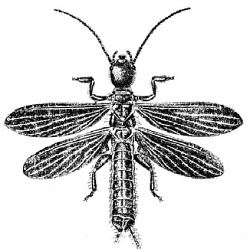Web-spinners (Order: Embioptera)

An illustration of a male Embia major.
A.D. Imms 1913.
Web-spinners are so called because they make silk-lined tunnels and webs under stones, in the soil or in dead wood. The tunnels protect them against predators, such as centipedes. The tunnels also help to maintain the right temperatures and humidity for them to live in - they create their own little world, in fact.
They're a little bit special because they spin the silk for their webs and tunnels from glands in a swollen joint of their front legs. No other insects are known to have silk glands in this position.
The name Embioptera is derived from the Greek embio, meaning lively and ptera, meaning wings, and refers to the fluttery movement of the two pairs of wings seen in the male. The females have no wings, and some males may have no wings either.
Web-spinners look a little like earwigs or termites, with small eyes, thread-like antennae and long bodies. Unlike earwigs, the tail structures (cerci) are soft and jointed, and the wings are darker than those of termites. The head is broad and carries biting jaws.
Web-spinners live in groups of webs or silk tunnels under leaf litter. Each tunnel contains a female and her eggs and nymphs, which she protects, in some cases giving them pre-chewed plant material to eat. She feeds on plant material, whilst the males probably don't eat and die soon after they mate (when they might get eaten by the female).
These insects are commoner in the tropics and subtropics than in more northerly, temperate regions.
Classification
There are only around 200 species of web-spinners worldwide, divided into 8 families. There are few species in Europe, and these are rarely seen. Embioptera are Orthopteroid (closely related to the Orthoptera and Plecoptera) and have incomplete metamorphosis (egg, nymph, adult).
How to find them
By looking for their webs in their habitat, under stones and in the soil, especially in the warmer climates where they are mostly found.
A to Z of insects
- Alderflies
- Ants
- Antlions
- Archaeognatha
- Barklice
- Bees
- Beetles
- Biting lice
- Booklice
- Butterflies
- Bugs
- Caddisflies
- Cockroaches
- Crickets
- Damselflies
- Dobsonflies
- Dragonflies
- Earwigs
- Fleas
- Flies
- Grasshoppers
- Lacewings
- Leaf insects
- Lice
- Mantids
- Mayflies
- Moths
- Praying Mantids
- Scorpionflies
- Snakeflies
- Stick insects
- Stoneflies
- Strepsipterans
- Sucking lice
- Termites
- Three-pronged bristletails
- Thrips
- True Bugs
- Wasps
- Web-spinners
- Zorapterans
- Non-insect hexapods
- Proturans
- Springtails
- Two-pronged bristletails
Back to Insect Orders.
![Amateur Entomologists' Society home page [Logo]](/images/aes-logo-wplant.gif)